JHVEPhoto/iStock Editorial via Getty Images
By Valuentum Analysts
At Valuentum, we use discounted cash-flow [DCF] analysis as the bedrock of our process. However, we also use relative valuation and technical and momentum indicators and blend that into an output called the Valuentum Buying Index [VBI] rating. We like to help members sort ideas in a systematic fashion so they can apply our work in any way that they would like. As shown in the flow chart below, we’ll show how The Walt Disney Company (NYSE:DIS) registers a 3 on the VBI, as it garners an undervalued perspective on our DCF process, a neutral view from a relative valuation basis, and bearish technical assessment. A pretty neat, process, with so much embedded in one number, no? Let us know in the comments below.
The flow chart shows how we derive a rating for each company. (Valuentum)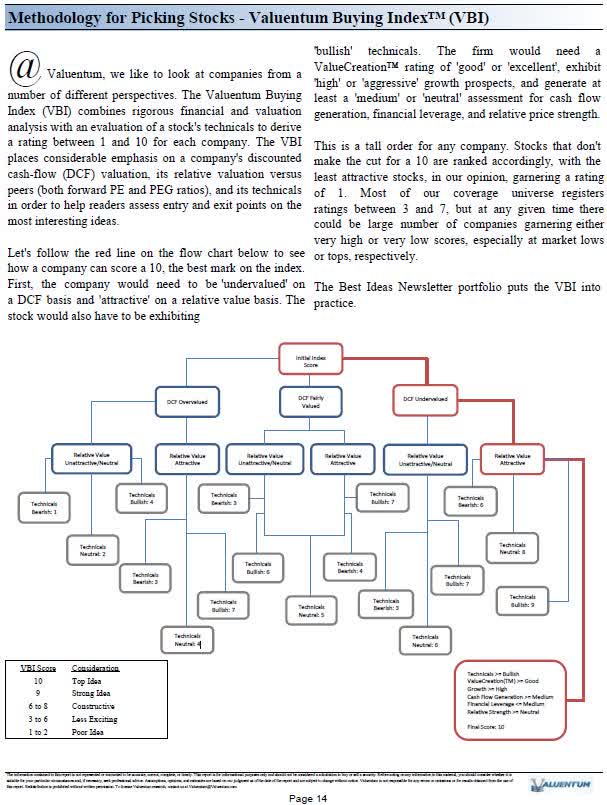
Let’s now talk Disney, in particular.
Disney is a diversified entertainment company with two main business operating segments: ‘Disney Media and Entertainment Distribution’ and ‘Disney Parks, Experiences and Products.’ Video streaming services are now a core part of Disney’s business model, supported by its well-known brand.
Looking ahead, it will be essential for Disney to prove to the market that its video streaming strategy can achieve profitability in the medium term, and we appreciate its efforts on this front with an eye towards recent pricing increases.
In the meantime, Disney’s theme parks and resorts operations should benefit from pent-up consumer demand for outdoors entertainment options after being cooped inside during much of the COVID-19 pandemic. Here’s how we look at the firm’s key investment considerations that help to derive the VBI rating.
Disney’s Key Investment Considerations
Image Source: Valuentum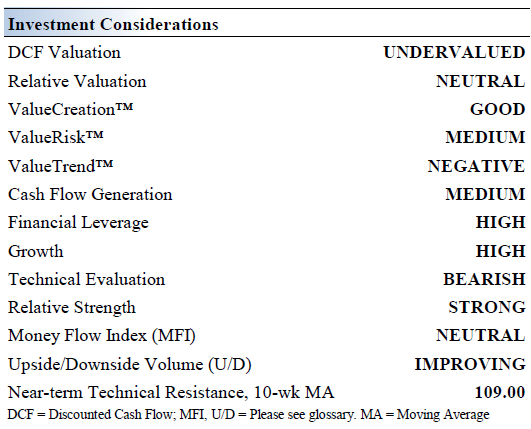
The long term looks bright at Disney. By the end of fiscal 2024, Disney aims to have around 300-350 million paid subscribers across its Disney+ (including Disney+ Hotstar), EPSN+, and Hulu video streaming services. Its Star and Star+ video streaming services offer room for additional upside.
The ongoing recovery at its theme parks and resorts operations combined with forecasted growth in the paid subscriber bases of its various video streaming services underpins its promising growth trajectory. Disney should also benefit when households across the globe start returning to the movie theaters in earnest.
Disney acquired 21st Century Fox for ~$71.3 billion in cash and stock after 21st Century was spun off from Fox (FOX). Disney now owns Fox’s film and TV studio, along with FX and National Geographic networks, highlighting the expansive nature of Disney’s content library. This deal gave Disney a majority stake in Hulu.
Disney suspended its semi-annual dividend payments in May 2020 to preserve cash amid the COVID-19 pandemic. The company is investing billions in original content for its video streaming services, which aren’t expected to be profitable until fiscal 2023/2024.
Disney’s Economic Profit Analysis
The best measure of a company’s ability to create value for shareholders is expressed by comparing its return on invested capital [ROIC] with its weighted average cost of capital [WACC]. The gap or difference between ROIC and WACC is called the firm’s economic profit spread. Disney’s 3-year historical return on invested capital (without goodwill) is 9.2%, which is above the estimate of its cost of capital of 8.1%.
As such, we assign the firm a ValueCreation™ rating of GOOD. In the chart below, we show the probable path of ROIC in the years ahead based on the estimated volatility of key drivers behind the measure. The solid grey line reflects the most likely outcome, in our opinion, and represents the scenario that results in our fair value estimate. As you can see, we’re expecting some strong returns from Disney in the coming years as its business bounces back.
Latest Earnings Analysis
On August 10, Disney reported third quarter earnings for fiscal 2022 (period ended July 3, 2022) that beat both consensus top- and bottom-line expectations. Its theme parks and reports business came roaring back from the worst of the COVID-19 pandemic while its video streaming services continued to add millions of paid subscribers to their customer bases.
At its ‘Disney Parks, Experiences, and Products’ business reporting segment, the company reported that its segment-level revenues grew 70% and that its segment-level operating income grew over six-fold on a year-over-year basis last fiscal quarter. Consumers are flocking to its theme parks and resorts now that COVID-19 restrictions in most countries have been substantially reduced or eliminated entirely. In the event China pivots away from its “zero COVID” policies, that could unleash another wave of demand for these offerings. Historically, Disney’s theme parks and resorts have been its major profit driver, and we appreciate that this part of its business is doing great again.
Pivoting to its ‘Disney Media and Entertainment Distribution’ business reporting segment, which houses its various video streaming services (including Disney+, ESPN+, and Hulu), the company reported that its segment-level revenues rose 11% and that its segment-level operating income declined 32% year-over-year last fiscal quarter. This segment’s losses were driven by its direct-to-consumer operations, meaning its video streaming services, as Disney is in the process of aggressively scaling up the business by expanding into international markets and developing original content to grow its collective paying subscriber bases.
On the plus side, across Disney+, ESPN+, and Hulu, the company added a combined 15.5 million net paying subscribers by the end of the third quarter of fiscal 2022 versus the end of the second quarter of fiscal 2022. That includes 14.4 million net paying subscribers at its flagship Disney+ service. One of the reasons why shares of Disney have performed quite well of late, in our view, is that its Disney+ service continues to grow its paid subscriber base at a robust clip.
During Disney’s latest earnings call, management updated the firm’s fiscal 2024 guidance as it concerns the company’s paying subscriber forecast for Disney+, lowering it down to 215-245 million by that period (includes expectations for 80 million subscribers at Disney+ Hotstar, largely focused on India and other South Asian markets) from 230-260 million previously. However, investors were expecting something much worse. Disney’s current guidance still calls for substantial growth at Disney+ given the service had 152.1 million paying subscribers at the end of the third quarter of fiscal 2022. At the midpoint of its latest guidance, Disney is forecasting that its Disney+ service will grow its paid subscriber base by over 51% through fiscal 2024.
Please note that Disney owns a controlling 67% stake in Hulu and by January 2024, Disney may have to shell outs billions to acquire the 33% stake in Hulu that Comcast Corporation (CMCSA) owns. How this situation resolves itself remains to be seen, though by January 2024, either Comcast can compel Disney to purchase or Disney can compel Comcast to sell that stake in Hulu. There is a floor price of $27.5 billion for all of Hulu, though Comcast will likely push for a higher price for obvious reasons.
By fiscal 2024, Disney aims to either break-even or generate a profit from its core video streaming services. Paid subscriber increases are one way the company aims to achieve that goal, with price increases being another. Disney recently implemented sizable pricing increases across its various video streaming services and will likely continue to do so going forward, with the pace of the increases dictated by market conditions and other factors. The moderate reduction in its paid subscriber growth forecast through fiscal 2024 shouldn’t significantly hamper Disney’s ability to eventually turn these loss making operations into cash flow cows, given its ample pricing power and ability to rationalize original content spend.
On a GAAP basis, Disney’s revenues rose 26% year-over-year to reach $21.5 billion while its GAAP operating income more than doubled to reach $2.1 billion last fiscal quarter. Its GAAP diluted EPS stood at $0.77 in the fiscal third quarter of fiscal 2022, up from $0.50 in the same period last fiscal year. Due to a large working capital build, Disney generated negative $0.3 billion in free cash flow during the first three quarters of fiscal 2022. Going forward, as its theme parks and resorts business continues to recover while its video streaming services scale to achieve profitability, Disney’s ability to generate “gobs” of positive free cash flows should return in earnest.
Disney exited the fiscal third quarter with a net debt load of $38.6 billion (inclusive of short-term debt). Its $13.0 billion in cash and cash equivalents on hand at the end of this period provides Disney with ample liquidity to meet its near-term funding needs.
Disney’s Cash Flow Valuation Analysis
We think Disney is worth $142 per share with a fair value range of $110- $174. The margin of safety around our fair value estimate is driven by the firm’s MEDIUM ValueRisk rating, which is derived from an evaluation of the historical volatility of key valuation drivers and a future assessment of them.
Our near-term operating forecasts, including revenue and earnings, do not differ much from consensus estimates or management guidance. Our model reflects a compound annual revenue growth rate of 14% during the next five years, a pace that is higher than the firm’s 3- year historical compound annual growth rate of 4.3%.
Our valuation model reflects a 5-year projected average operating margin of 13.8%, which is above Disney’s trailing 3-year average. Beyond year 5, we assume free cash flow will grow at an annual rate of 3.7% for the next 15 years and 3% in perpetuity. For Disney, we use an 8.1% weighted average cost of capital to discount future free cash flows.
Disney’s Margin Of Safety Analysis
Our discounted cash flow process values each company on the basis of the present value of all future free cash flows. Although we estimate the company’s fair value at about $142 per share, every company has a range of probable fair values that’s created by the uncertainty of key valuation drivers (like future revenue or earnings, for example). After all, if the future were known with certainty, we wouldn’t see much volatility in the markets as stocks would trade precisely at their known fair values.
Our ValueRisk rating sets the margin of safety or the fair value range we assign to each stock. In the graph above, we show this probable range of fair values for Disney. We think the firm is attractive below $110 per share (the green line), but quite expensive above $174 per share (the red line). The prices that fall along the yellow line, which includes our fair value estimate, represent a reasonable valuation for the firm, in our opinion. With shares of DIS trading around ~$100 each, they look quite cheap, from our perspective.
Concluding Thoughts
Disney’s brand strength is undeniable, and its theme park operations are a staple. Though the near term has been rocky and its streaming operations are facing growing competition from established players and new entrants alike, we still like shares over the long haul. On the basis of our fair value estimate, Disney’s shares look cheap to us. What do you think?
This article or report and any links within are for information purposes only and should not be considered a solicitation to buy or sell any security. Valuentum is not responsible for any errors or omissions or for results obtained from the use of this article and accepts no liability for how readers may choose to utilize the content. Assumptions, opinions, and estimates are based on our judgment as of the date of the article and are subject to change without notice.


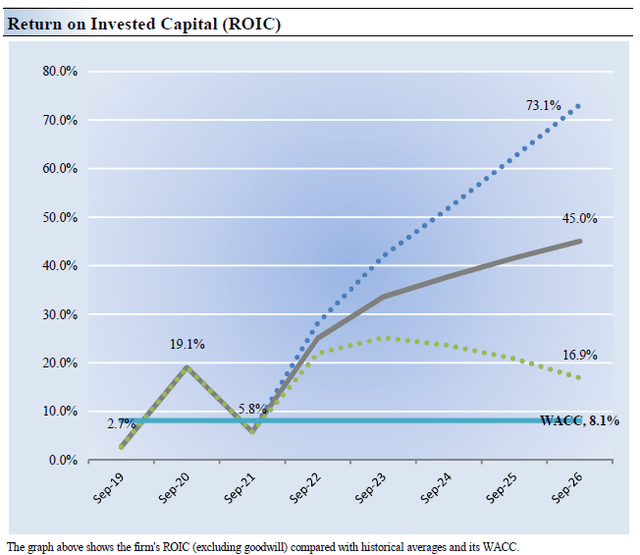
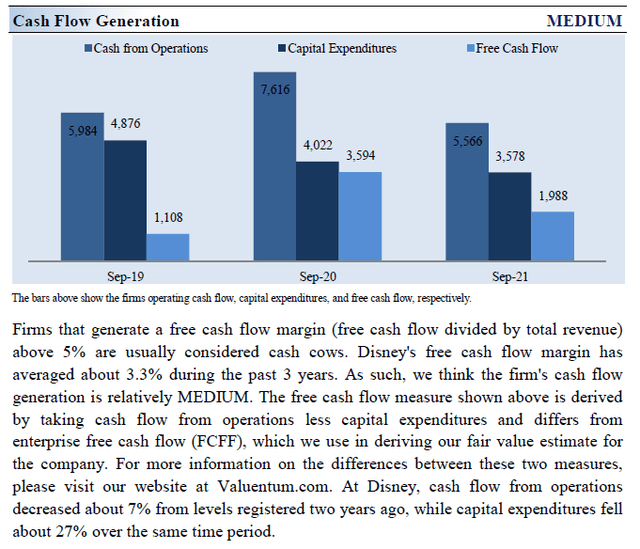
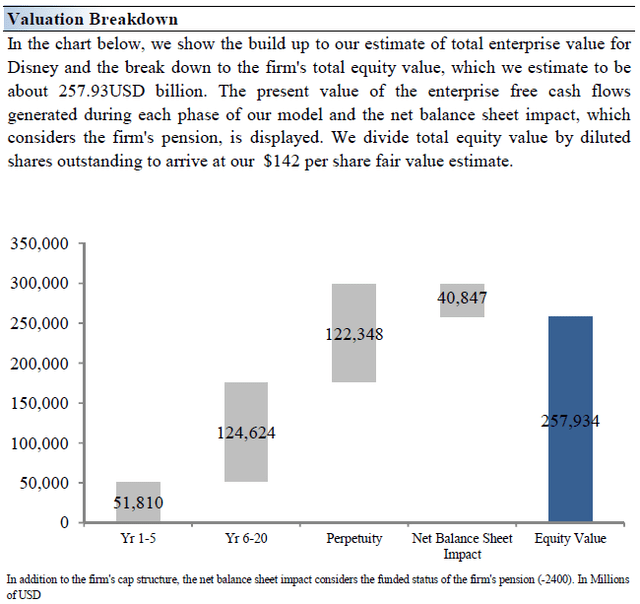
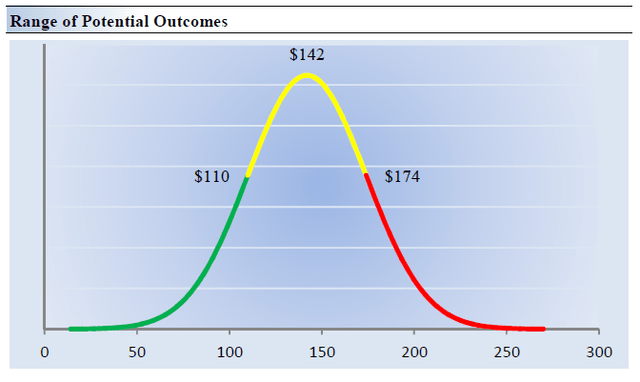
Be the first to comment